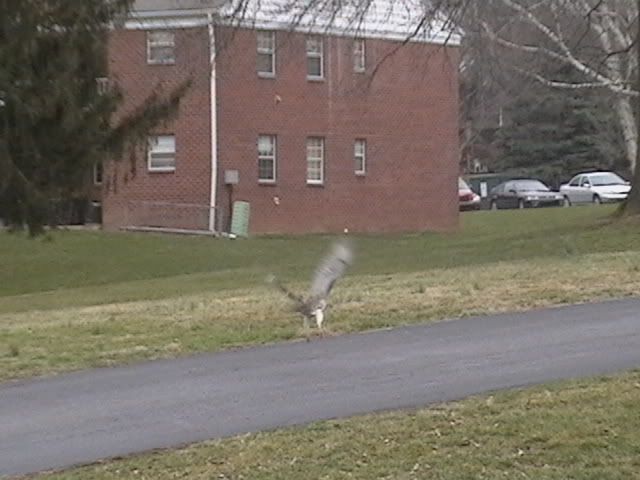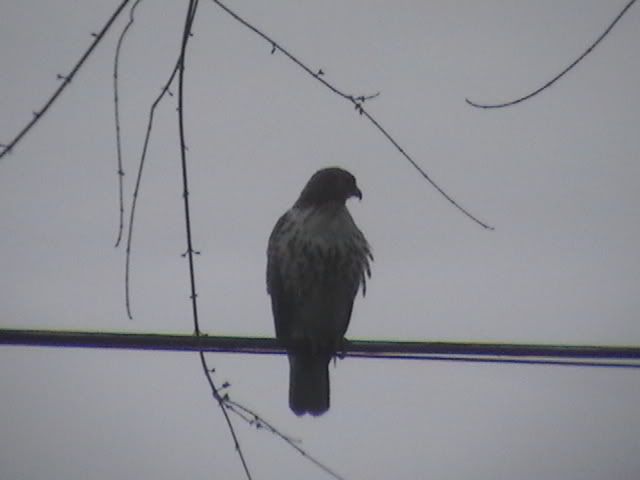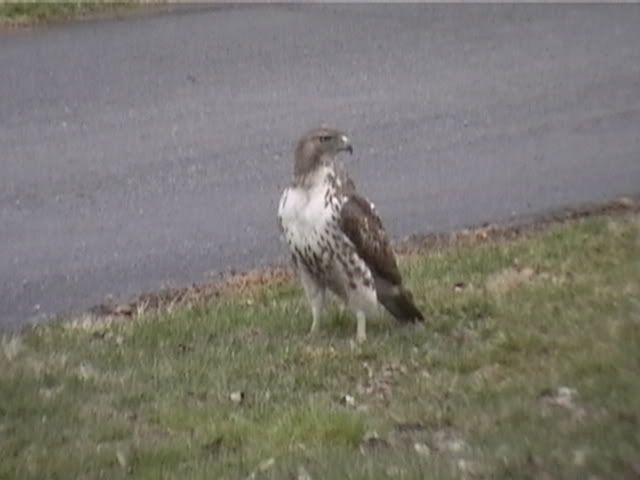Here are some more Pics of Juvenile Red Tailed Hawks!



Here is a Mature Adult!

And here is some Info:
CLASS: Aves
ORDER: Falconiformes
FAMILY: Accipitridae
SubFamily: Buteoninae
GENUS & SPECIES: Buteo jamaicensis
CLASSIFICATION:
Falconiformes includes all hawks, and accipiter means hawk in Latin, as does buteo (well, an eagle is a hawk and a falcon is a hawk...). Jamaicensis refers to the site of the first discovery and identification of the Red-tail.
 RANGE: Almost anywhere in North America
RANGE: Almost anywhere in North America
PHYSICAL DESCRIPTION:
Length: 43-63.5cm
Height: wingspan - 109-143cm
Weight: Male - 880-1000 grams; female - 1250-1500 grams
Coloration: The usual color is a dark brown on the head and back, and rusty streaks or a rusty wash over the breast and belly, with dark spots on the tips of the upper belly feathers which, at a distance, give the bird a dark belly band (one of its main field identification traits) and a rusty "red" tail, which is gray and whitish from underneath.
Juveniles have a dark brown or black-banded tail, dorsally and ventrally. The tips of the primaries are black, but the bases are white or cream, giving the appearance of a translucent "window" in the wing tip (as compared with the large translucent window at the wrist of the Red Shouldered Hawk, another Buteo which looks very similar in flight.)
There is a wide range of color variation in the Red Tail and one can find specimens dark brown ventrally (with a black belly band), making a completely dark bird (easily confused with another Buteo, the Rough-legged Hawk) and, on the other end, a light brown dorsum with a cream head and belly (with small spots, so the belly band is still evident) and pink tail.
DIET:
Zoo: Bird of prey diet - 3 times a week. Birds are given meat on the bone or fresh kills on the regular keepers 2nd day off.
Wild: Small mammals, snakes, lizards, frogs, fish and insects. They kill rabbits, ground and tree squirrels, but also catch birds up to the size of prairie chickens.
ADAPTATIONS:
Typical of all Buteos, the Red Tail is a master soarer and takes advantage of daily thermals in the summer months. In cooler weather, these birds must rely on perch hunting.
Like eagles and other hawks, the Buteos, including the Red-tail, have a boney ridge over the orbit that provides shade for the eyes while in direct sunlight, an adaptation similar to built-in baseball caps. The protruding brow ridge often makes them look perpetually angry. Other types of birds that spend much time in the sun have similar structures. Ostriches and other ratites have boney ridges also.
Another adaptation of the eye is the scleral ring. The eyeball is so large that it need internal support. The eyeballs of birds actually touch on the mid-line of the skull and all birds have the boney scleral ring to some degree. It is carried to extreme in the owl.
BEHAVIOR:
An extremely versatile raptor, it combines the characteristics of soaring and the rapid flight of accipiters. Like all Buteos, they are often seen perched on a prominance (rock, fence post or telephone pole) patiently watching for prey.
As with all raptors, pellets are regurgitated and food-habits studies are easily carried out.
BREEDING AND GROWTH:
Breeding season is from March to May. Nests are in small trees and bushes of Taiga, in shrubs in swamp hills of Florida and on old cactus stems in deserts of Mexico. It will choose cliff rock pockets or palms trees or large trees of a wooded area near its grassy feeding area, making use of almost any habitat within its range that contains appropriate food.
The male initiates the nest building. After courtship, the female builds with material brought by the male. These large hawks will use the same nest year after year, adding to it each season, but they will readily change nest sites or rebuild if necessary. Not to be pushed out of their territory easily, territorial claim-staking done by both of the pair with high circling and much calling over the nest area.
If there is enough food to support other hunters, they will allow other species in the area [I know of a canyon where a red-tail nest is within an acre of a Great-Horned Owl nest and a Spotted Owl nest...Burleigh] but they do not like other red-tails in the area. Human encroachment is tolerated to a point, but they may stoop and talon a human near their nest tree.
The nest is lined with fine roots, grasses and green twigs, making a nice cup. The female lays 2 to 5 eggs of the same type as the common buzzard [not vulture, remember]. Eggs measure 59.5 x 47.2 mm, about the same as a chicken egg.
Incubation is by the female, with the male providing and standing guard. Incubation is about 50 days and the nestling period lasts about 120 days. Fledges will stay with the parents, even returning with them to the nest area in spring, but are not allowed to remain in the nest area when the new season starts. Whenever they leave the parents, siblings often travel together for a time. Maturity, and the "red" tail come in the second to third year.
RELATED:
Bald Eagle
Bateleur Eagle
Cinereous Vulture
Harris Hawk
Here is the Site













 Reply With Quote
Reply With Quote


 Makes me feel badly, setting up all those small birds for "supper."
Makes me feel badly, setting up all those small birds for "supper."









 RANGE: Almost anywhere in North America
RANGE: Almost anywhere in North America



Bookmarks